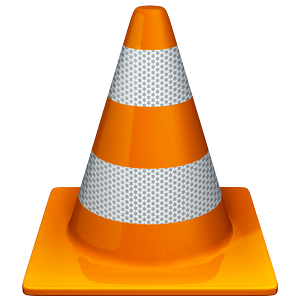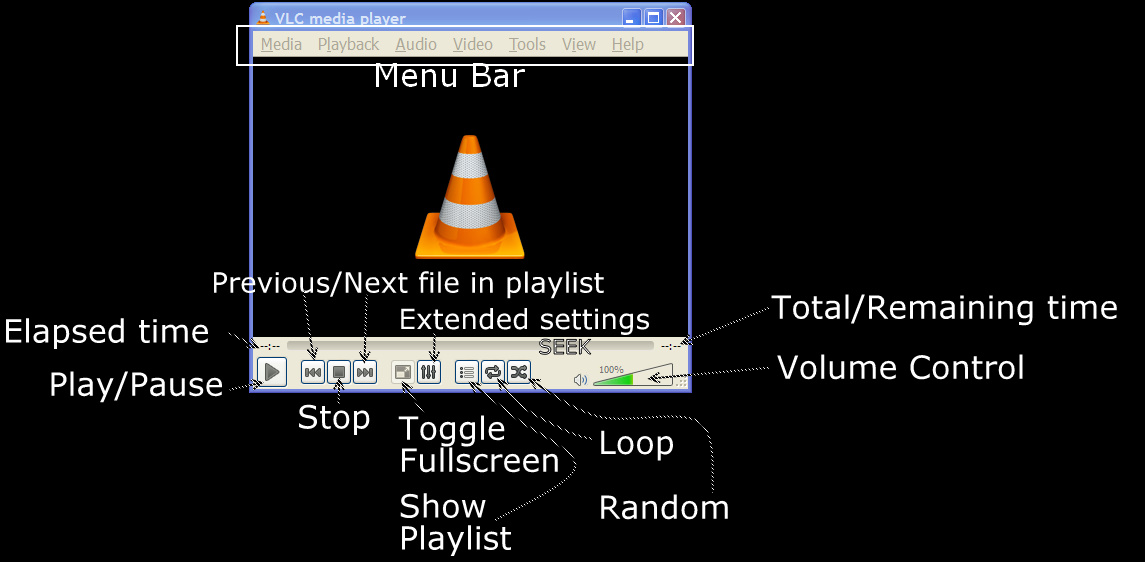Difference between revisions of "Documentation:VLC for dummies"
m (Change Mac OS X → macOS) |
(Unlink File:Icon.png, scaled to 30px. We have {{VLC icon}} that inserts a 22-px image. Why make them different?) |
||
| (One intermediate revision by the same user not shown) | |||
| Line 81: | Line 81: | ||
*[[Documentation:Play_HowTo/Basic_Use/Interface|Basics of VLC]] | *[[Documentation:Play_HowTo/Basic_Use/Interface|Basics of VLC]] | ||
**Windows | **Windows | ||
| − | ***[[Documentation:Play_HowTo/Basic_Use/Interface#Starting_VLC_Media_Player|starting VLC]]<br> Double click the VLC icon | + | ***[[Documentation:Play_HowTo/Basic_Use/Interface#Starting_VLC_Media_Player|starting VLC]]<br> Double click the VLC icon {{VLC icon}} on the desktop or from the start menu: select ''Programs'', select ''VideoLAN'' and select ''VLC media player''. |
**[[Documentation:Play_HowTo/Basic_Use/Open#Play_a_file|Playing media files stored in the computer]] | **[[Documentation:Play_HowTo/Basic_Use/Open#Play_a_file|Playing media files stored in the computer]] | ||
***Queuing files<br /> You can queue files by selecting multiple files at a time. | ***Queuing files<br /> You can queue files by selecting multiple files at a time. | ||
| Line 92: | Line 92: | ||
*[[Common Problems]] | *[[Common Problems]] | ||
| − | + | *[[Hotkeys]] | |
| − | |||
| − | |||
**[[How to set global hotkeys]] | **[[How to set global hotkeys]] | ||
Latest revision as of 01:46, 23 March 2019
Thank you for visiting this page to find out what VLC media player is all about. Please Note: this page is Under Construction and might change in the near future.
VLC media player (or VLC for short) is a FREE and Open Source Software Media Player. Features that make VLC the preferred media player for a lot of people are its excellent support for various Audio and Video codecs, the fact that it's cross platform and the open way of development.
This page describes the basic use of VLC. See VLC Play HowTo for a user guide and VLC Streaming HowTo for advanced streaming features.
Contents
Prerequisites
To use VLC you need:
- A computer with Internet access and an internet (web) browser (to download VLC).
What is a web browser? - Media (audio or video) files or Disc (optical drive required to play discs).
- Audio output hardware (speakers, headphones) for audio playback.
- Knowledge about working with computer files and folders.
Working with files and folders (MSFT Windows)
How to open documents and folders (macOS)
Files, folders & search (Ubuntu)
The main interface
Interface overview
The following picture shows the names of the main controls in the VLC interface:
Note: This picture corresponds to the Windows XP version. In other systems, VLC might look slightly different.
Menu bar
The menu bar at the top contains commands that control VLC.
Track slider
![]()
The track slider is on top of the control buttons. It shows the progress of playing of the media file. You can drag the track slider left to rewind or right to forward the track being played.
Two timers at the left and right ends of the track slider show the current playing position (left) and the total time (right) of the current track.
Note: When a media file is streamed (live), the position indicator of the track slider does not move because the total duration of the streaming is not known until it finishes.
Control buttons
The buttons below the slider control the playback.
From left to right they are:
- Play/Pause.
- Previous media in the playlist.
- Stop playback.
- Next media in the playlist.
- Toggle fullscreen (video only).
- Show extended settings: Audio effects, Video effects and Synchronization.
- Show playlist.
- Repeat: toggles among loop all, loop one, no loop (default).
- Random: Plays the files in the current playlist in a random order.
Volume control
The volume control is located in the bottom right corner of the window. The small speaker icon is a button that mutes (![]() ) or un-mutes (
) or un-mutes (![]() ) the sound. The triangle to the right is a slider that shows the current playback volume. Clicking this slider modifies the volume. The playback volume is also displayed as a percentage number on top of this slider.
) the sound. The triangle to the right is a slider that shows the current playback volume. Clicking this slider modifies the volume. The playback volume is also displayed as a percentage number on top of this slider.
Windows notification area (system tray) icon
When you start VLC media player, the application appears on the screen and a small icon ![]() appears in the notification area (system tray). Clicking once this icon will hide VLC, and clicking it again will show it again. Hiding VLC does not close it, it continues to run in the background. Right clicking this icon brings up a menu with the following controls:
appears in the notification area (system tray). Clicking once this icon will hide VLC, and clicking it again will show it again. Hiding VLC does not close it, it continues to run in the background. Right clicking this icon brings up a menu with the following controls:
- Hide/Show VLC media player.
- Play/Pause/Stop playback.
- Switch to Previous/Next track.
- Speed control.
- Increase/Decrease volume.
- Mute.
- Open media.
- Quit.
Tutorials
- Installing VLC
- Basics of VLC
- Windows
- starting VLC
Double click the VLC icon on the desktop or from the start menu: select Programs, select VideoLAN and select VLC media player.
on the desktop or from the start menu: select Programs, select VideoLAN and select VLC media player.
- starting VLC
- Playing media files stored in the computer
- Queuing files
You can queue files by selecting multiple files at a time.
- Queuing files
- Playing media from your optical reader (CD, DVD, Blu-Ray)
- Closing VLC
- Windows
